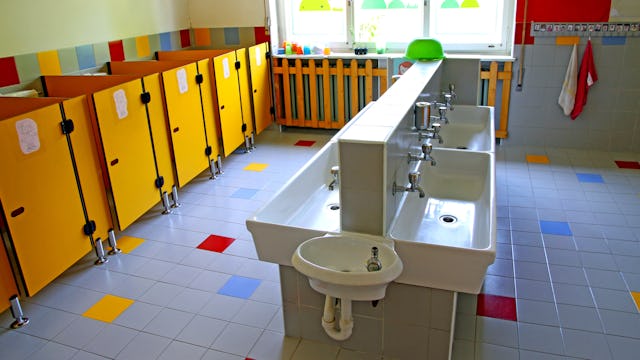Schools Are Restricting Kids' Bathroom Breaks And It's Affecting Their Health

We need to do better about kids’ bathroom rights in school
Adults can go to the bathroom whenever they please — at home, at work, out in public. When you’ve gotta go, you’ve gotta go, right? So why don’t we treat children in school with the same respect? Recent research shows that when kids’ bathroom needs aren’t being met in school, it has a negative effect on their health.
A recent survey conducted by the Society for Women’s Health Research (SWHR) found that it’s commonplace for schools to disregard the bathroom rights of students. Most often, schools are failing to have official bathroom rules and providing staff with education on bladder health. Teachers are often left to come up with their own regulations — which isn’t always effective.
The survey garnered responses from 362 school nurses, covering pre-K/elementary, middle, and high schools across rural, suburban, and urban areas. Less than 8% of nurses reported that their schools have a written policy on student bathroom use (64% reported no policy, 28% were unsure). Nearly half said students have free bathroom access, with permission required only as a formality, while others reported varying timed and supervised bathroom breaks.
The reality is most schools want to minimize the amount of time students spend in the bathroom, especially when class is in session. While this seems like an effective use of learning time, it does present a problem. Restricting kids’ access to the bathroom can have serious health implications, especially when a child needs to go to the bathroom but isn’t allowed to do so.
“Restricting access to the bathroom forces students into unhealthy toileting habits, such as holding in urine, which may create health problems that will follow students into adulthood and decrease their quality of life,” says Rebecca Nebel, PhD, SWHR’s director of scientific programs.
Holding in urine can weaken bladder muscles, which can lead to leakage and increased susceptibility to urinary tract infections. Children especially need to use the bathroom regularly — every two to three hours, according to research. Waiting until their bladders are ready to burst isn’t good for them.
Many of us can probably remember strict bathroom rules back in our school days. While high school bathrooms are more prone to…uh…shenanigans, and it’s understandable why school administrators and teachers would want to reduce time wasted in there, you still have to let kids go to the bathroom when they need to go. One time I was on an antibiotic that made me pee constantly, and it was super embarrassing having to excuse myself multiple times throughout the day. It was even more embarrassing watching my teacher frown at me for asking to go so much.
Christopher Cooper, a pediatric urologist at the University of Iowa, tells The Atlantic that the psychological responses to physiological sensations are a “crucial point of development” in elementary students. According to Cooper, children are “very good at ignoring [their bladder] signals” after being regularly denied the opportunity to go when they feel the urge.
Anyone who has a young child knows hands-down this is true. And the side effects of ignoring those signals puts stress on the bladder, which can make it overactive.
Kids aren’t the only ones who have limited bathroom time at school — teachers do too. Without adequate classroom coverage — even for just a few minutes — most teachers don’t have the opportunity to relieve themselves as often as they should throughout the day.
Bottom line: schools need to do better when it comes to bathroom breaks. For everyone.